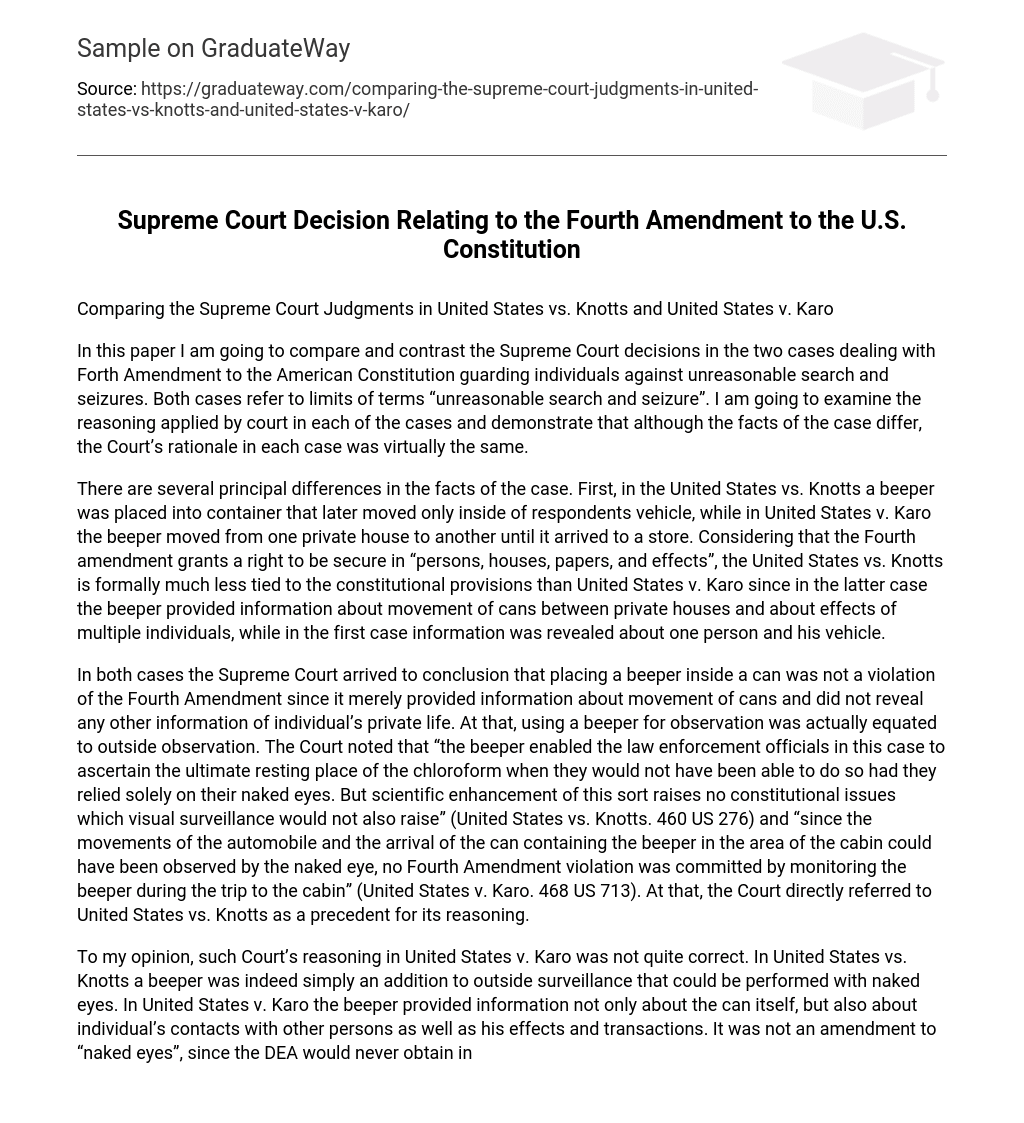In this paper, I will compare and contrast the Supreme Court decisions in two cases dealing with the Fourth Amendment to the American Constitution, which guards individuals against unreasonable searches and seizures. Both cases refer to the limits of the term unreasonable search and seizure.” I will examine the reasoning applied by the court in each case and demonstrate that although the facts of each case differ, the Court’s rationale was virtually identical.
There are several principal differences in the facts of the case. First, in United States vs. Knotts, a beeper was placed in a container that later moved only inside the respondent’s vehicle. In contrast, in United States v. Karo, the beeper moved from one private house to another until it arrived at a store.
Considering that the Fourth Amendment grants a right to be secure in persons, houses, papers, and effects,” United States vs. Knotts is formally much less tied to constitutional provisions than United States v. Karo since in the latter case, the beeper provided information about movement of cans between private houses and about effects of multiple individuals while revealing information about one person and his vehicle only in the first case.
In both cases, the Supreme Court concluded that placing a beeper inside a can did not violate the Fourth Amendment. The beeper only provided information about the movement of cans and did not reveal any other private information about an individual’s life. The Court equated using a beeper for observation to outside observation. They noted that the beeper enabled law enforcement officials in this case to ascertain the ultimate resting place of the chloroform when they would not have been able to do so had they relied solely on their naked eyes.” However, scientific enhancement like this does not raise any constitutional issues that visual surveillance would also raise (United States vs. Knotts, 460 US 276). Additionally, since the movements of the automobile and arrival of the can containing the beeper in the area of the cabin could have been observed by naked eye, no Fourth Amendment violation was committed by monitoring it during its trip to cabin (United States v. Karo, 468 US 713). The Court directly referred to United States vs. Knotts as a precedent for its reasoning.
In my opinion, the Court’s reasoning in United States v. Karo was not entirely correct. In United States v. Knotts, a beeper was simply an addition to outside surveillance that could be performed with the naked eye. However, in United States v. Karo, the beeper provided information not only about the can itself but also about an individual’s contacts with other persons as well as their effects and transactions. It was not an amendment to naked eyes” since the DEA would never obtain information it has obtained without a beeper.
Nevertheless, I agree that no violation of the Fourth Amendment occurred in either case. The term “search” implies that a premise is entered without the owner’s consent so that their private life is essentially affected while “seizure” means taking someone’s property under court order and without their consent.
Neither of these situations can be observed in either case since all information could have been obtained through outside observation alone; although, in both cases, law enforcement failed to make such observations without a beeper.
It should be kept in mind that the Supreme Court does not alter or amend the Constitution. It simply interprets Constitutional provisions and makes them applicable to particular cases. In United States vs. Knotts and United States v. Karo, the Court merely explained that the Fourth Amendment is not applicable to technical means like beepers and equated such means to outside observation. However, the Fourth Amendment has not been changed in any way.
Bibliography:
1. United States v. Knotts, 460 U.S. 276 (1983), can be found at http://supreme.justia.com/us/460/276/case.html and was retrieved on July 26, 2009.
2. United States v Karo, 468 U.S. 705 (1984). The case can be found at http://supreme.justia.com/us/468/705/case.html and was retrieved on July 26, 2009.





